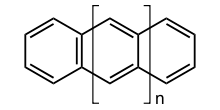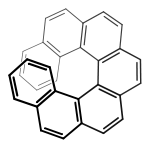Acene
The acenes or polyacenes are a class of organic compounds and polycyclic aromatic hydrocarbons made up of linearly fused benzene rings.[1][2] The larger representatives have potential interest in optoelectronic applications and are actively researched in chemistry and electrical engineering. Pentacene has been incorporated into organic field-effect transistors, reaching charge carrier mobilities as high as 5 cm2/Vs.

The first 5 unsubstituted members are listed in the following table:
| Name | Number of rings | Molecular formula | Structural formula |
|---|---|---|---|
| Anthracene | 3 | C14H10 |  |
| Tetracene | 4 | C18H12 |  |
| Pentacene | 5 | C22H14 |  |
| Hexacene | 6 | C26H16 |  |
| Heptacene | 7 | C30H18 |  |
Hexacene is not stable in air, and dimerises upon isolation. Heptacene (and larger acenes) is very reactive and has only been isolated in a matrix. However, bis(trialkylsilylethynylated) versions of heptacene have been isolated as crystalline solids.[3]
Larger acenes
Due to their increased conjugation length the larger acenes are also studied.[4] Theoretically, a number of reports are available on longer chains using density functional methods.[5][6] They are also building blocks for nanotubes and graphene. Unsubstituted octacene (n=8) and nonacene (n=9)[7] have been detected in matrix isolation. The first reports of stable nonacene derivatives claimed that due to the electronic effects of the thioaryl substituents the compound is not a diradical but a closed-shell compound with the lowest HOMO-LUMO gap reported for any acene,[8] an observation in violation of Kasha's rule. Subsequent work by others on different derivatives included crystal structures, with no such violations.[9] The on-surface synthesis and characterization of unsubstituted, parent nonacene (n=9)[10] and decacene (n=10)[11] have been reported.
Related compounds
The acene series have the consecutive rings linked in a linear chain, but other chain linkages are possible. The phenacenes have a zig-zag structure and the helicenes have a helical structure.
- Macromolecular forms consisting of seven fused benzene rings
 Heptacene
Heptacene [7]Phenacene
[7]Phenacene M-heptahelicene
M-heptahelicene
References
- IUPAC, Compendium of Chemical Terminology, 2nd ed. (the "Gold Book") (1997). Online corrected version: (2006–) "acenes". doi:10.1351/goldbook.A00061
- Electronic structure of higher acenes and polyacene: The perspective developed by theoretical analyses Holger F. Bettinger Pure Appl. Chem., Vol. 82, No. 4, pp. 905–915, 2010. doi:10.1351/PAC-CON-09-10-29
- Anthony, John E. (2008). "The Larger Acenes: Versatile Organic Semiconductors". Angewandte Chemie International Edition. 47 (3): 452–83. doi:10.1002/anie.200604045. PMID 18046697.
- Zade, Sanjio S.; Bendikov, Michael (2010). "Heptacene and Beyond: the Longest Characterized Acenes". Angewandte Chemie International Edition. 49 (24): 4012–5. doi:10.1002/anie.200906002. PMID 20468014.
- Wu, Chun-Shian; Chai, Jeng-Da (2015-05-12). "Electronic Properties of Zigzag Graphene Nanoribbons Studied by TAO-DFT". Journal of Chemical Theory and Computation. 11 (5): 2003–2011. doi:10.1021/ct500999m. ISSN 1549-9618.
- Seenithurai, Sonai; Chai, Jeng-Da (2016-09-09). "Effect of Li Adsorption on the Electronic and Hydrogen Storage Properties of Acenes: A Dispersion-Corrected TAO-DFT Study". Scientific Reports. 6 (1): 33081. arXiv:1606.03489. Bibcode:2016NatSR...633081S. doi:10.1038/srep33081. ISSN 2045-2322. PMC 5016802. PMID 27609626.
- Tönshoff, Christina; Bettinger, Holger F. (2010). "Photogeneration of Octacene and Nonacene". Angewandte Chemie International Edition. 49 (24): 4125–8. doi:10.1002/anie.200906355. PMID 20432492.
- Kaur, Irvinder; Jazdzyk, Mikael; Stein, Nathan N.; Prusevich, Polina; Miller, Glen P. (2010). "Design, Synthesis, and Characterization of a Persistent Nonacene Derivative". Journal of the American Chemical Society. 132 (4): 1261–3. doi:10.1021/ja9095472. PMID 20055388.
- Purushothaman, Balaji; Bruzek, Matthew; Parkin, Sean; Miller, Anne-Frances; Anthony, John (2011). "Synthesis and Structural Characterization of Crystalline Nonacenes". Angew. Chem. Int. Ed. Engl. 50 (31): 7013–7917. doi:10.1002/anie.201102671. PMID 21717552.
- Nonacene Generated by On-Surface Dehydrogenation Rafal Zuzak, Ruth Dorel, Mariusz Krawiec, Bartosz Such, Marek Kolmer, Marek Szymonski, Antonio M. Echavarren, Szymon Godlewski, ACS Nano, 2017, 11 (9), pp 9321–9329 doi:10.1021/acsnano.7b04728
- Decacene: On-Surface Generation J. Krüger, F. García, F. Eisenhut, D. Skidin, J. M. Alonso, E. Guitián, D. Pérez, G. Cuniberti, F. Moresco, D. Peña, Angew. Chem. Int. Ed. 2017, 56, 11945. doi:10.1002/anie.201706156